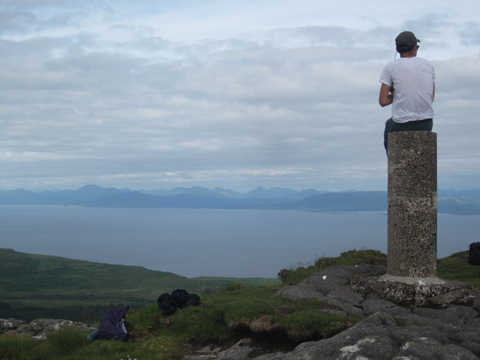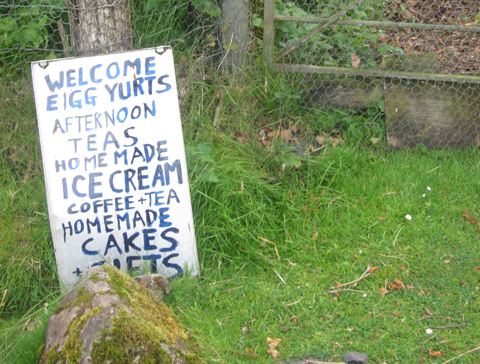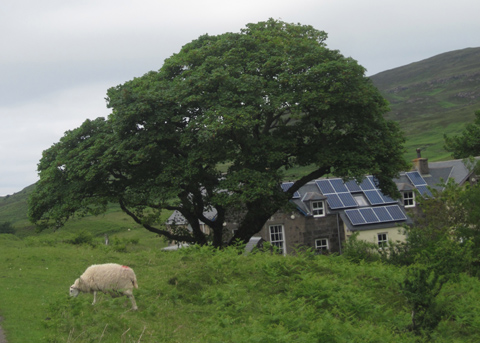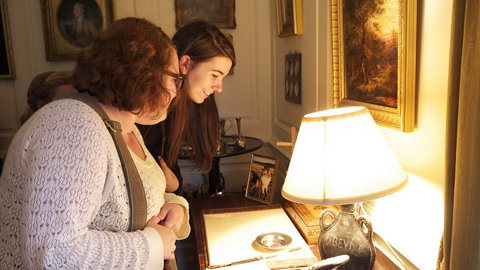By Lori Bauer
The Isle of Eigg wasn’t on the schedule.
But students took advantage of a free weekend to add a journey to the small island off the coast of Scotland. It turned into an adventure.
The students were in Scotland for the Summer 2014 Edinburgh: City and the Environment Program, taught by Geography Professor Geoff Buckley. They had a free weekend. But Janice Brewer decided she couldn’t miss the opportunity to visit Eigg.
“I told the other students that I was going no matter what, and that they were welcome to come along, therefore we made a group trip out of it. It did take some convincing of a few but, oh boy, were they thanking Sara and I once we arrived,” Brewer recalls.
“It didn’t take long for everyone in the program to jump on board. Janice and I began looking into prices of train tickets, ferry times, and campsites, eventually giving us the affectionate nicknames ‘Mama Jan’ and ‘Mama Sara,'” says Sara Sand.
The Isle of Eigg provided quite the contrast with Edinburgh.
“With our cities and environment course, I realized that urban and rural areas are on two completely different scales, which can make it harder to compare and contrast. The two areas tend to have different needs. For example, the Isle of Eigg was more self-reliant while Edinburgh relied more on public transit and food imports. Their economies were also on different scales. The Isle of Eigg consumed less in general and had little to no tourist attraction while Edinburgh’s economic development is currently relying on tourists and consumerist citizens to keep the money flowing. The people of the island did seem to be more connected to one another than in Edinburgh, I guess that would happen when you are basically isolated with 87 people on a 3×5 mile island,” Brewer says.
Camping on an Organic Farm
“Upon planning, I researched the island to ensure I got more out of my experience rather than just visiting as a tourist,” Brewer says. “The ferry does not travel to these small island on a daily basis, so we had to plan our train times around the ferry. We stayed the night at a campsite in Malaig the night before departing for Eigg, which is the town where the ferry leaves from.
“Upon researching the island, I found the only true campsite to be at Eigg Organics, owned by Sue and Neil. This is a small organic farm with a campsite, yurt, and compost toilet. In their home, they requested a 2 pound donation for using the shower to help pay for heating and water costs, which to me displayed an awareness of energy use and consumption. They also had a small greenhouse on their property. I got the chance to ask Neil a few questions about his farm operation. He stated that ‘in a bad year, my farm provides enough for me, while in a good year, it provides more than enough for me and also for my neighbors.’ Neil said that about eight to nine families grow their own food and one lady on the island bakes bread. Other sustainable efforts included recycling awareness and bins at the ferry port.”
A Lot of Energy Goes into Sustainability
On a day hike, the group stumbled upon a hydroelectric dam after climbing a waterfall.
“We didn’t really think anything of it until we got to town and saw a photo of the dam and realized that this was an energy source for the island. The dam was in the middle of the island away from any homes or human living spaces. I know it has been many years since it was built, but the environments seemed to be restored and flourishing. To me, this showed human innovation interacting with nature in a way to benefit each other,” says Brewer. She is majoring in Bachelor of Specialized Studies – Sustainable Food System Planning and Development at Ohio University. She is also the Food Matters club vice president, associated with the Food Studies curricular theme. She works at Shagbark Seed & Mill in Athens, OH.
“Throughout our time in Scotland, we discussed how an urban lifestyle can lead to a more sustainable life. The Isle of Eigg had none of these elements that make a city sustainable. With only 32 house holds on the island, a lot of energy is expended to bring goods to this small group of people, especially considering that everything must be brought in on ferries,” says Sand.
“However, this also means that the residents of the island live more simply and sustainably because of the high cost and high difficulty of receiving many products,” she says. “They don’t seem to have a lot of consumer goods. It appears that they reuse what they can. This is also what has lead them to generate all of their own energy through sustainable wind, solar, and hydroelectric. Instead of constantly running generators for each household, they are able to have their own grid. Ultimately, their sustainability seems to simply stem from the fact that they live on a tiny island and have to make accommodations. Many of the people on the island grow their own natural food. the farm that we were staying on had compost toilets. It simply makes their life easier.”
“Eigg was very different in my opinion from Edinburgh,” shares Christian Haskins. “Eigg had a very isolationist perspective being a few miles off the mainland. They absolutely relied on the mainland for certain things such as royal mail, firewood (lack of suitable trees on island), and certain food products. Eigg was also different for its complete renewable energy system; 100% of its energy is produced by natural sources, which we saw in the form of wind, solar and water power. Edinburgh is a major city and energy wise runs on much more energy than the small island of Eigg. With its differences in size, Edinburgh is doing all it can to be a ‘green’ city. Portland, Oregon, is a city that in my opinion would compare to Edinburgh.”
Out of Economic Necessity…
“It is still hard to compare urban history with island history because they are again on two different scales to be measured however it does not seem that the island people have strayed too far from what their heritage has been practicing for decades. Generally, each inhabitant had a croft—”a small rented farm, especially one in Scotland, comprising a plot of arable land attached to a house and with a right of pasturage held in common with other such farms”—but these have slowly declined as technology has advanced. Neil stated that now that they have this electricity grid that they are able to live easier lives, but that has caused the community to rely less on each other and rely more on the ease of technology. Before they created the grid, homes were run on generators,” Brewer says.
“In my personal opinion,” she adds, “I think that part of this initiative was out of necessity. Yes, these people are being more sustainable and projecting a more sustainable lifestyle while having a decreased human impact, but they are completely isolated. They may have taken this initiative to ensure their livelihoods, survival, and self-reliance. This site tells in more detail the history of the island. In terms of urban history, these areas have thrived and created a greater human impact also because of survival, but in an urban scale, economic survival. People left rural areas, where they may have been struggling and isolated to make money and allow their family to survive. Richard Rodger stated to our class that these rural areas must have really been bad if people were willing to move to the city and live in cramped, unsanitary, and simply miserable housing situations. The human impact in this case is greater and the environment is more built up than island areas, but both are for reasons of human development and survival.”
A Sunset They Won’t Forget
“The coolest thing I saw on the island was the view from our campsite,” Haskins adds. “The campsite was a four-mile walk from the ferry on the opposite side of the island. Our view was from a small sustainable farm hilltop, situated in a really cool geologic bowl. The view was of the Isle of Rum, and the sunsets were incredible not only for their beauty but also for being at 11:30 p.m. most nights!”
“Ultimately, this adventure to the Isle of Eigg was probably the most amazing experience of my summer. Not only did I see the most beautiful sunset of my life, but I was able to truly see a different way of living. One of my favorite moments of being on Eigg was when we climbed to the highest point and you could see almost the entire island; there were the solar panels, and the wind turbines, and the small hydroelectric dam, and the sheep grazing in the perfectly green fields, and the cows napping on the beach. Everything that these people relied on was laid out before us. I always remember what the worker at the Edinburgh train station said to us when we realized that the ferry only went to the island four times a week: ‘There just isn’t a lot of transportation to this part of the world.’ I feel really lucky that I got to go such an incredible place that so few people ever see,” adds Sand.
“It is very likely that this island was the highlight of my summer,” Brewer says. “Beyond nerding out about their sustainability practices, just unzipping my tent in the morning to the view of an organic garden and the sun rising over the Isle of Rum across the way…..absolutely unreal, but very real to the Isle of Eigg inhabitants.
“I keep having this reoccurring thought about Scotland and the Isle of Eigg: The beauty of these people’s country is blatantly right in front of them. The rolling hills, the mountaintops, the clear streams, the green EVERYthing surrounds them, which also means that what they have at stake, or what they have to lose, is right in front of them also, whereas in the states, it feels more common to have an out of sight, out of mind experience with the beauty of our country. If we want to go somewhere as breathtaking as this, we have to not only travel quite a long distance, but we have to take off work and pay a lot money, which many cannot do,” she adds.
Haskins adds that his most memorable experience of my summer in Edinburgh “was when I took the train ride from Edinburgh to Mallaig. It was about seven hours, and all of us were booked together on the train. One section of the train passes the Glenfinnan Viaduct, an awesome bridge best known for as the “Harry Potter bridge.” The train ride itself has been named on several top 10 train ride lists in the world. It was truly eye opening to see all of what Scotland is about on one track.”
























Comments